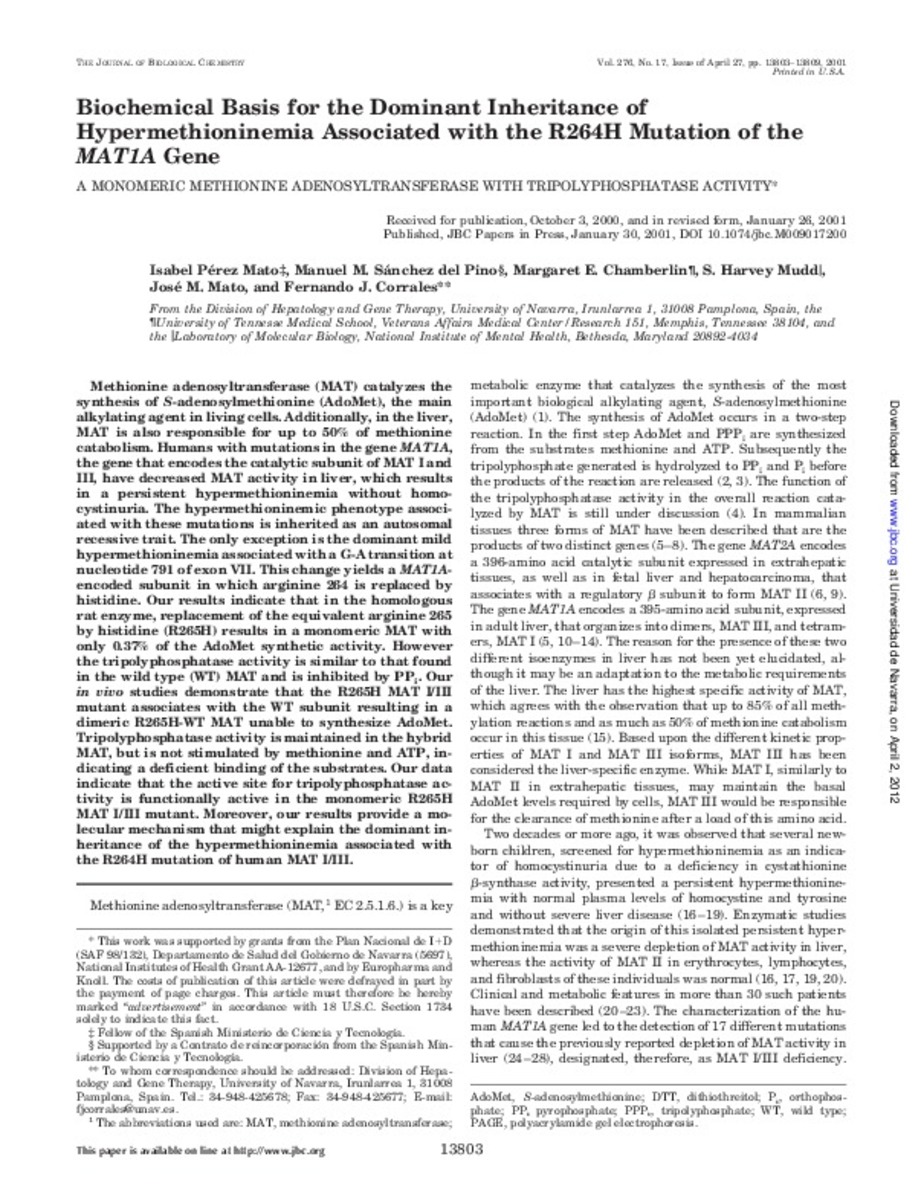Full metadata record
| DC Field | Value | Language |
|---|---|---|
| dc.creator | Perez-Mato, I. (Isabel) | - |
| dc.creator | Sanchez-del-Pino, M.M. (Manuel M.) | - |
| dc.creator | Chamberlin, M.E. (Margaret E.) | - |
| dc.creator | Mudd, S.H. (S. Harvey) | - |
| dc.creator | Mato, J.M. (José María) | - |
| dc.creator | Corrales, F.J. (Fernando José) | - |
| dc.date.accessioned | 2012-04-02T13:02:36Z | - |
| dc.date.available | 2012-04-02T13:02:36Z | - |
| dc.date.issued | 2001 | - |
| dc.identifier.citation | Perez Mato I, Sanchez del Pino MM, Chamberlin ME, Mudd SH, Mato JM, Corrales FJ. Biochemical basis for the dominant inheritance of hypermethioninemia associated with the R264H mutation of the MAT1A gene. A monomeric methionine adenosyltransferase with tripolyphosphatase activity. J Biol Chem 2001 Apr 27;276(17):13803-13809. | es_ES |
| dc.identifier.issn | 1083-351X | - |
| dc.identifier.uri | https://hdl.handle.net/10171/21526 | - |
| dc.description.abstract | Methionine adenosyltransferase (MAT) catalyzes the synthesis of S-adenosylmethionine (AdoMet), the main alkylating agent in living cells. Additionally, in the liver, MAT is also responsible for up to 50% of methionine catabolism. Humans with mutations in the gene MAT1A, the gene that encodes the catalytic subunit of MAT I and III, have decreased MAT activity in liver, which results in a persistent hypermethioninemia without homocystinuria. The hypermethioninemic phenotype associated with these mutations is inherited as an autosomal recessive trait. The only exception is the dominant mild hypermethioninemia associated with a G-A transition at nucleotide 791 of exon VII. This change yields a MAT1A-encoded subunit in which arginine 264 is replaced by histidine. Our results indicate that in the homologous rat enzyme, replacement of the equivalent arginine 265 by histidine (R265H) results in a monomeric MAT with only 0.37% of the AdoMet synthetic activity. However the tripolyphosphatase activity is similar to that found in the wild type (WT) MAT and is inhibited by PP(i). Our in vivo studies demonstrate that the R265H MAT I/III mutant associates with the WT subunit resulting in a dimeric R265H-WT MAT unable to synthesize AdoMet. Tripolyphosphatase activity is maintained in the hybrid MAT, but is not stimulated by methionine and ATP, indicating a deficient binding of the substrates. Our data indicate that the active site for tripolyphosphatase activity is functionally active in the monomeric R265H MAT I/III mutant. Moreover, our results provide a molecular mechanism that might explain the dominant inheritance of the hypermethioninemia associated with the R264H mutation of human MAT I/III. | es_ES |
| dc.language.iso | eng | es_ES |
| dc.publisher | American Society for Biochemistry and Molecular Biology | es_ES |
| dc.rights | info:eu-repo/semantics/openAccess | es_ES |
| dc.subject | Genes, Dominant | es_ES |
| dc.subject | Methionine/blood | es_ES |
| dc.subject | Methionine/genetics | es_ES |
| dc.subject | Methionine Adenosyltransferase/genetics | es_ES |
| dc.subject | Mutation | es_ES |
| dc.title | Biochemical basis for the dominant inheritance of hypermethioninemia associated with the R264H mutation of the MAT1A gene. A monomeric methionine adenosyltransferase with tripolyphosphatase activity | es_ES |
| dc.type | info:eu-repo/semantics/article | es_ES |
| dc.relation.publisherversion | http://www.jbc.org/content/276/17/13803 | es_ES |
| dc.type.driver | info:eu-repo/semantics/article | es_ES |
Files in This Item:
Statistics and impact
Items in Dadun are protected by copyright, with all rights reserved, unless otherwise indicated.






